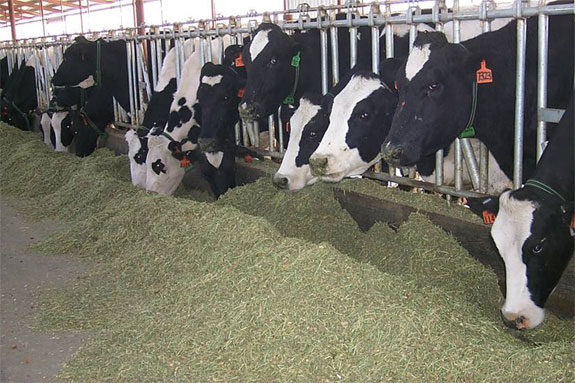The dairy industry in a five-state region – Colorado, Kansas, Oklahoma, New Mexico and Texas – has seen a tremendous growth in the past decade, a growth that provides both concerns and opportunities, according to Texas AgriLife Extension Service specialists. Joining other experts at the High Plains Dairy Conference held recently in Amarillo, Dr. Ellen Jordan, a Texas AgriLife Extension Service dairy specialist, said the five-state area is home to about 450,000 cows, which provide approximately $4.3 billion in annual economic impact.
Click here to learn more about the recent High Plains Dairy Management Conference.
However, water use by these dairies and in the industry has been questioned, especially after the drought of last year.
“We are the newcomers on the block, so we are receiving some of the blame for water levels going down,” Jordan said. “We are seeing a higher demand for feed grains, driven primarily by the dairy industry. But a lot of that product is being imported into the region.”
Jordan said the industry uses about 28,000 acre feet of water per year directly for drinking water and facility cleaning, or about the equivalent of 22,000 acres of cropland.
A dairy cow and the heifer grown to replace her will eat about 9.7 pounds of alfalfa, 92 pounds of silage, 18.84 pounds of concentrate, 4.9 pounds of cottonseed, 4.6 pounds of protein and 1.2 pounds of mineral each day.
“That’s 10.8 million tons of feed a year that the dairies in the Southern Ogallala feed,” she said. “It would take 1.5 million acre feet of water if we were producing 100 percent of that in this area.”
But a high percentage of the corn, distiller’s grains, soybean meal and other products are not grown regionally, so the water use is not that high, Jordan said.
Jordan joined forces with AgriLife Extension economists Dr. Bridget Guerrero, Lubbock, and Dr. Steve Amosson, Amarillo, to evaluate the economic impacts to the region.
The team used a software program called IMPLAN to estimate the dairy industry generates about $1.7 billion from milk sales and $1.39 billion from processing for an overall impact of $3.09 billion.
“That’s a new industry to this region in the past 15 years, and as a result, we’ve seen new Wal-Marts, Holiday Inn Expresses and other businesses in some of these communities,” Jordan said.
“And that doesn’t count the indirect impact from employment, trucking and such. The economic impact is $4.3 billion from it all, with more than half of that economic income in Texas.”
So the economic benefits are there, Jordan said. However, that doesn’t mean the industry shouldn’t be looking for ways to meet the water challenges and be good water stewards, she said.
Some criticisms or suggestions have been to stop or reduce the amount of alfalfa fed, eliminate the practice of double-cropping, switch to more sorghum, use drought-resistant crops, improve irrigation efficiencies and import more feed, she said.
However, Jordan said, the elimination of alfalfa would only reduce the amount of water a cow and her calf use through feed per year from 17.8 acre inches to 16.8 acre inches.
And, she said, double-cropping corn for silage at a dairy may actually use less water than growing the corn for grain for three reasons: No pre-watering is needed, less mature crops require less water, and up to 10 percent of the water comes from lagoons at the dairy.
Dr. Dana Porter, AgriLife Extension engineer from Lubbock, and Dr. Brent Bean, AgriLife Extension agronomist in Amarillo, each discussed ways dairy producers could make a difference in the water they use.
Porter said efficient advanced irrigation technologies, such as low-pressure center-pivot systems, are widely used in the High Plains, especially in areas where well capacities have long been a limiting factor. Knowing what works best for a particular operation is key to efficient water use.
Improvements such as land-leveling can help those still using surface irrigation, she said. Producers using center pivot systems need to know the capacity of their wells, monitor pressure and distribution uniformity to ensure the outside span is getting the proper water, and re-nozzle when necessary.
Drip irrigation is another option for good managers, Porter said. Although it is more expensive than other methods, it is friendly to automation. Pressure gauges and flow meters must be monitored to detect problems before they show up as dead plants in the field.
Management and maintenance are key to efficient irrigation regardless of the method used, she said.
Bean said dairy producers can find forage sorghums that are equal to corn in supporting milk production, but variety selection is very important, so “pay attention.”
“When determining whether to grow corn or sorghum silage, it really depends on the available water,” he said. “There’s about a 30 percent difference between the water use of fully irrigated corn and sorghum.”
While lodging can be an issue on forage sorghums, Bean said it can be reduced by reducing seeding rates and not over-fertilizing with nitrogen.
“And harvest on time,” he said. “When it is at the right moisture, harvest, or it might end up on the ground.” PD
—From AgriLife Today
PHOTO
Water concerns are being addressed by the dairy industry as a higher demand for feed grains is in part driven by the growth the industry has seen in the High Plains. Photo courtesy of Texas AgriLife Extension Service; photographer is Dr. Ellen Jordan.











